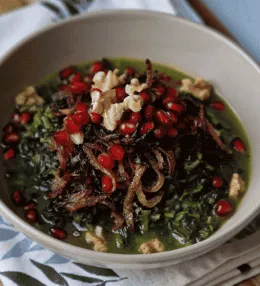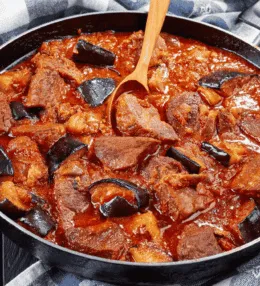
- View
Table of Contents
ToggleThe Scotch egg is a food that feels equally at home in a picnic basket, a pub, or on a kitchen table. It brings together two staples of British cooking, the egg and the sausage, in a way that feels playful yet satisfying. Crisp, hearty, and portable, it has become an enduring favourite.
Beneath the surface of breadcrumbs lies a boiled egg, soft or firm depending on preference, wrapped in seasoned sausage meat. Once fried or baked, it develops a golden crust that crackles under the bite, revealing layers that are both rustic and inviting.
While it can be eaten warm, the Scotch egg has a charm when served cold as well. It lends itself to casual eating, often enjoyed with pickles or mustard. This dual nature is part of what has kept it firmly on British tables for generations.
Want to dive deeper into British Cuisine? Don’t miss our post on Traditional British Foods to Try
What Is a Scotch Egg?
A Scotch egg is, in essence, a boiled egg encased in sausage meat, coated in breadcrumbs, and fried or baked until crisp. It is simple in concept but leaves plenty of room for variation in preparation and seasoning.
The egg at the centre can be cooked to different stages. Some versions favour a soft yolk that oozes gently when cut, while others lean toward a firmer centre that holds shape neatly. Both approaches have loyal followings.
The sausage coating is typically made from pork, though other meats and vegetarian options now exist. Once covered in breadcrumbs, the egg is fried until crisp, though baking is sometimes chosen for a lighter result.
Ingredients and Taste
The foundation of a Scotch egg is straightforward. Eggs provide the heart of the dish, wrapped in well-seasoned sausage meat mixed with herbs such as sage or parsley. Breadcrumbs are used to create the crunchy exterior.
When fried, the breadcrumbs form a crisp shell that gives way to savoury sausage and finally the egg. The result is a play of textures, moving from crunch to tenderness in just one bite. Each layer has its own presence but works in harmony.
The flavour leans rich and savoury, with the sausage carrying much of the weight. Fresh herbs lift the meat, while mustard or chutney often provides contrast. It is filling, hearty, and made to be eaten without fuss.
A Taste of History
The origins of the Scotch egg are still debated. Some trace it back to Fortnum and Mason in the 18th century, where it was prepared as a ready-to-eat snack for wealthy travellers setting out on long journeys.
Another account suggests northern England, where meat and eggs were practical staples of farm life. Similar dishes have existed across Europe, which makes its exact birthplace difficult to pin down. What is clear is its early popularity.
Over time, it found its place in British pub culture and outdoor eating. Its portability made it a natural fit for picnics, and its richness suited it to long afternoons with ale or cider. It became less of a novelty and more of a staple.
Today, the Scotch egg has taken on new forms. Chefs experiment with quail eggs, venison, or spicy coatings, but the core idea remains unchanged. It is still a dish where simplicity, flavour, and tradition meet in one compact package.
How to Make Scotch Egg (Egg in Sausage Coating)
Scotch Eggs are a classic British favourite that balance crisp golden crumb, seasoned sausage, and soft egg centre. Expect rich flavour, satisfying crunch, and a hearty bite. They make an excellent snack, picnic addition, or pub style treat. See the recipe card at the bottom for printable directions
Ingredients
For the eggs
- 6 large eggs (4 for the centre, 2 for coating)
- Cold water for boiling
For the sausage coating
- 500g good quality pork sausage meat
- 1 tsp English mustard
- 1 tsp fresh thyme leaves (or ½ tsp dried thyme)
- 1 garlic clove, finely grated
- ½ tsp nutmeg, freshly grated
- Salt and black pepper, to taste
For the breadcrumb coating
- 100g plain flour
- 150g fresh breadcrumbs
- Oil for deep frying (vegetable or sunflower)
Cooking Instructions
Step 1: Boil the eggs
To begin, place 4 eggs in a saucepan of cold water. Bring to a gentle boil, cook for 6 minutes for a soft centre or 8 minutes for a firmer yolk. Transfer immediately to iced water to stop cooking. Peel carefully once cooled. Transition to preparing sausage mixture.
Step 2: Prepare the sausage mixture
In a large bowl, combine sausage meat with mustard, thyme, garlic, nutmeg, salt, and pepper. Mix lightly with your hands until evenly combined. Do not overwork to keep the meat tender. Move to shaping portions.
Step 3: Divide the sausage mixture
Divide the sausage meat into 4 equal portions. Roll each into a ball, then flatten into a thin round patty large enough to wrap around an egg. Prepare the dredging station next.
Step 4: Set up coating station
Place flour on one plate, beat 2 eggs in a shallow bowl, and spread breadcrumbs on another plate. This three-stage coating ensures crisp results. Transition to wrapping eggs.
Step 5: Wrap the eggs
Roll each peeled egg in flour, then place in the centre of a sausage patty. Carefully shape the sausage meat around the egg, sealing any cracks with damp hands. Coat all 4 eggs. Continue to coating with crumbs.
Step 6: Coat with breadcrumbs
Dip each sausage covered egg into beaten egg, then roll in breadcrumbs, pressing lightly to secure an even coat. For extra crunch, repeat the egg wash and breadcrumb coating. Transition to frying.
Step 7: Heat the oil
Pour oil into a deep pan or fryer to a depth of about 7–8 cm. Heat to 170°C. Test with a cube of bread: it should brown in 40 seconds. Move to frying.
Step 8: Fry the Scotch eggs
Lower the coated eggs gently into the hot oil. Fry in batches for 6–8 minutes, turning occasionally, until the sausage meat is fully cooked and the coating is deep golden. Transition to draining.
Step 9: Drain and rest
Remove the Scotch eggs with a slotted spoon and drain on kitchen paper. Rest for 5 minutes to allow the crust to firm up. Transition to serving.
Final Step: Serve hot or cold
Slice in half and serve warm with mustard or brown sauce. Alternatively, chill and pack for a picnic. Presentation tip: place halved Scotch eggs on a wooden board with pickles for a pub style serving.
Variations and substitutions
- Meat substitute: Replace pork sausage meat with chicken or turkey mince for a lighter version.
- Spice adjustment: Swap thyme with sage for a more traditional herb pairing.
- Coating option: Use panko breadcrumbs if fresh ones are not available, for extra crunch.
- Vegetarian version: Wrap eggs in well-seasoned mashed chickpeas or vegetarian sausage mix.
Cooking Tips for Perfect Scotch Eggs
- Use room temperature eggs before boiling to avoid cracking.
- Keep sausage layer thin but even to ensure thorough cooking.
- Double coat in breadcrumbs for an extra crisp shell.
- Fry in batches to keep oil temperature consistent.
- Rest fried eggs briefly before slicing to prevent crumbling.

Scotch Egg (Egg in Sausage Coating)
Ingredients
For the eggs
- 6 large eggs 4 for the centre, 2 for coating
- Cold water for boiling
For the sausage coating
- 500 g good quality pork sausage meat
- 1 tsp English mustard
- 1 tsp fresh thyme leaves or ½ tsp dried thyme
- 1 garlic clove finely grated
- ½ tsp nutmeg freshly grated
- Salt and black pepper to taste
For the breadcrumb coating
- 100 g plain flour
- 150 g fresh breadcrumbs
- Oil for deep frying vegetable or sunflower
Instructions
- To begin, place 4 eggs in a saucepan of cold water. Bring to a gentle boil, cook for 6 minutes for a soft centre or 8 minutes for a firmer yolk. Transfer immediately to iced water to stop cooking. Peel carefully once cooled. Transition to preparing sausage mixture.
- In a large bowl, combine sausage meat with mustard, thyme, garlic, nutmeg, salt, and pepper. Mix lightly with your hands until evenly combined. Do not overwork to keep the meat tender. Move to shaping portions.
- Divide the sausage meat into 4 equal portions. Roll each into a ball, then flatten into a thin round patty large enough to wrap around an egg. Prepare the dredging station next.
- Place flour on one plate, beat 2 eggs in a shallow bowl, and spread breadcrumbs on another plate. This three-stage coating ensures crisp results. Transition to wrapping eggs.
- Roll each peeled egg in flour, then place in the centre of a sausage patty. Carefully shape the sausage meat around the egg, sealing any cracks with damp hands. Coat all 4 eggs. Continue to coating with crumbs.
- Dip each sausage covered egg into beaten egg, then roll in breadcrumbs, pressing lightly to secure an even coat. For extra crunch, repeat the egg wash and breadcrumb coating. Transition to frying.
- Pour oil into a deep pan or fryer to a depth of about 7–8 cm. Heat to 170°C. Test with a cube of bread: it should brown in 40 seconds. Move to frying.
- Lower the coated eggs gently into the hot oil. Fry in batches for 6–8 minutes, turning occasionally, until the sausage meat is fully cooked and the coating is deep golden. Transition to draining.
- Remove the Scotch eggs with a slotted spoon and drain on kitchen paper. Rest for 5 minutes to allow the crust to firm up. Transition to serving.
- Slice in half and serve warm with mustard or brown sauce. Alternatively, chill and pack for a picnic. Presentation tip: place halved Scotch eggs on a wooden board with pickles for a pub style serving.
Nutrition
You May Also Like







Leave a Review